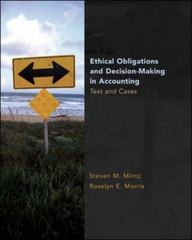Question
During the 20X6 fiscal year, Sterling engaged in several shareholders' equity and financing transactions. The following are the various transactions that have occurred in the
During the 20X6 fiscal year, Sterling engaged in several shareholders' equity and financing transactions. The following are the various transactions that have occurred in the year:
x. On January 1, 20X3, Sterling granted stock options to senior executives that enable them to purchase 80,000 shares. The exercise price was $85 per share, which was the same as the market price on the day the options were granted. The options vest three years after their grant date; employees who leave prior to that date forfeit the options. All of the executives who hold the options still remain with the company. Using an options pricing model, the fair value of the options was determined to be $180,000. All of the options expire at the end of 20X6; none were exercised during 20X5. The estimated forfeiture rate at the end of the year is 0%. The option offering is referred to as ESOP (employee stock option plan) plan 20X3.
xi. On March 1, 20X6, 15,000 of the options issued on January 1, 20X3, were exercised; the shares were trading at $112 per share at that time. On October 1, 20X6, a further 5,000 options issued on January 1, 20X3, were exercised. The shares were trading at $127 per share on October 1. The cash received was credited to the "common shares ESOP plan 20X3" account. (Hint: Common shares ESOP plan 20X3 needs to be closed as if it were a contributed surplus account.)
xii. This is the second time the company has offered a stock option program to its senior executives. The board of directors and the compensation committee were surprised that only 20,000 of the 80,000 options were exercised. Remaining options expired but there were no entries made for these expired options. In the previous offering (known as ESOP plan 20X1), 50,000 of the available options were exercised before they expired at the end of 20X4.
xiii. On April 1, 20X5, Sterling granted 100 stock appreciation rights (SARs) each to 252 employees in middle management. Employees who remain with the company for three years are entitled to exercise the SARs on April 1, 20X8. On April 1, 20X5, the benchmark price of the SARs (the market value of the shares) was $90. At the end of 20X5, it was estimated that 65% of the 252 employees will qualify to exercise the SARs. On December 31, 20X6, it was estimated that 60% of the 252 employees will qualify to exercise the SARs.
Date Fair value of SARs Market value of shares
April 1, 20X5 Not required $90.00
December 31, 20X5 $23.00 $110.00
December 31, 20X6 $26.45 $130.00
xiv. In January 20X6, Sterling issued $2,000,000 of 20-year, 7%, convertible bonds that pay interest annually on December 31. The bonds were issued when the market rate was 7.5%. Bond issuance costs were $231,000. 15 years after 20X6, the bonds can be converted to ordinary shares at the rate of four $100 bonds for two ordinary shares. The bonds sold for $2,204,771.
The sale of the bonds was recorded in Sterling's accounting records as follows:
DR Cash 2,204,771
CR Convertible bonds payable 2,204,771
DR Bond transaction expenses 231,000
CR Cash 231,000
Interest payments are due on December 31. Due to a computer problem, the December 31, 20X6, payments were not made.
Provide the journal entries for each of the above issues. Provide a bonds payable amortization table, a stock appreciation rights worksheet, a convertible bonds payable amortization table, and any other working papers necessary to support the journal entries.
Step by Step Solution
There are 3 Steps involved in it
Step: 1

Get Instant Access to Expert-Tailored Solutions
See step-by-step solutions with expert insights and AI powered tools for academic success
Step: 2

Step: 3

Ace Your Homework with AI
Get the answers you need in no time with our AI-driven, step-by-step assistance
Get Started


